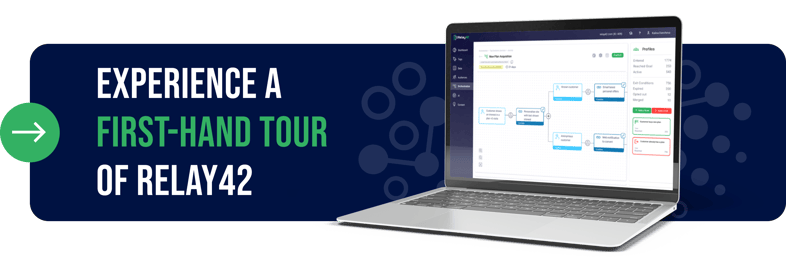9 Digital Advertising Solutions for the Cookieless World
by Anthony Botibol on 1.5.2023

The digital marketing landscape is undergoing its most significant overhaul since the advent of programmatic advertising with Google Chrome's intent to phase out third-party cookies by 2024.*
The reliance on third-party data has long been the subject of intense scrutiny, with sweeping regulations like GDPR transforming the privacy sphere. With increasing global privacy mandates, the era of leveraging third-party cookies for targeting prospective consumers is drawing to a close.
Advertisers are now pressed to transition their acquisition plans towards harnessing their own first-party data to sustain programmatic advertising and retargeting effectiveness. While many brands have embraced this change, their approaches often fall short in sophistication due to data cleanliness issues, insufficient data access, or unclear methodologies to bridge first-party data with their ad tech.
Third-party cookies are gradually fading: a victory for consumer privacy, yet a predicament for marketers
Previously, the convenience provided by third-party cookies for crafting personalized ads effortlessly across optimal channels has been a significant boon for companies of various scales. Marketers could sculpt and categorize pertinent audiences through accessible profile and behavioral data via DMPs and DSPs, and cookies have further allowed them to gauge the efficacy of their ad spend.
Although third-party data extends a substantial reach towards engaging consumers beyond a brand's own databases and systems, employing pixels and trackers to tailor experiences without truly recognizing the consumer's distinct identity remains questionable under stringent regulations like the GDPR.
For instance, under the GDPR stipulations, identifiers such as IP addresses and device IDs, which are staples in most cookies, qualify as Personally Identifiable Information (PII). Thus, lacking explicit consent for processing this data precludes its lawful use for marketing objectives.
While collecting explicit email marketing consent is relatively straightforward, delineating digital consent for third-party cookies across a myriad of websites becomes convoluted and daunting due to the intricate nature of real-time preference and behavior data collection.
The solution? Abandoning reliance on third-party cookies altogether. While browsers like Safari and Mozilla/Firefox have begun thwarting consumer data sharing, Google's dominant search market share implies that its efforts to detach from third-party cookies are poised to disrupt digital marketing the most by its 2024 deadline* massively.
Certain brands are heavily anchored in third-party data audiences to propel their advertising and customer acquisition tactics, using first-party data narrowly to refine ad expenditure by either excluding or retargeting customers. More advanced entities, however, employ their first-party data for creating lookalike models within advertising and social platforms.
The expansive reach provided by third-party data poses a critical question: how will advertisers and digital marketers fulfill their customer acquisition goals with the substantially reduced scope of their adverts? Moreover, without third-party cookies imparting feedback to marketers on ad performance, how can they execute attribution modeling to ascertain the triumphs of their digital marketing endeavors and conversions?
9 potential first-party data solutions for advertisers
The following are nine potential strategies advertisers may consider to steer clear of third-party cookie dependency. A unifying element among these solutions is the imperative of obtaining coherent, structured first-party customer data. This involves ensuring comprehensive data access and centralizing it through a Customer Data Platform (CDP) to render it actionable in alignment with the subsequent burgeoning solutions.
- Identity Management Solutions
- Google Privacy Sandbox
- First Party and Zero party data collection and unification
- Publisher-Provided IDs (PPIDs)
- Contextual Advertising
- Data Pools or Data Clean Rooms
- User ID Graphs
- Digital Fingerprinting
- Second-party data partnerships
Identity Management Solutions
 These tools and services assist companies in coordinating user identity details across a multitude of platforms and touchpoints. A Customer Data Platform (CDP) is optimal for capturing and joining identities to create unified customer profiles, and thereby empowering businesses to personalize their messaging and promotions based on these insights. Moreover, the rise of Data Clean Rooms, Google Privacy Sandbox solutions, and other novel customer acquisition methods underscore the importance of robust ID management and the effective use of first-party data in these solutions, making it a vital requisite for ongoing customer acquisition in a cookieless world.
These tools and services assist companies in coordinating user identity details across a multitude of platforms and touchpoints. A Customer Data Platform (CDP) is optimal for capturing and joining identities to create unified customer profiles, and thereby empowering businesses to personalize their messaging and promotions based on these insights. Moreover, the rise of Data Clean Rooms, Google Privacy Sandbox solutions, and other novel customer acquisition methods underscore the importance of robust ID management and the effective use of first-party data in these solutions, making it a vital requisite for ongoing customer acquisition in a cookieless world.
Google Privacy Sandbox
 The Google Privacy Sandbox initiative encompasses a suite of technologies designed to enhance privacy online, such as Google's Protected Audience API (previously known as Google FLEDGE), which aims to limit third-party cookie usage and protect user data for retargeting programs. Google's inherent interest in keeping ad budgets consistent demands them to address advertiser concerns. These solutions primarily bank on brands inputting their first-party data anonymously into Google's Clean Room (Google PAIRS) or utilizing it for retargeting purposes through the Protected Audience API. Linking your first-party data with Google's API and/or PAIRS can assist marketing teams in adapting to these shifts more smoothly and crafting personalized ad experiences without the crutch of third-party cookies.
The Google Privacy Sandbox initiative encompasses a suite of technologies designed to enhance privacy online, such as Google's Protected Audience API (previously known as Google FLEDGE), which aims to limit third-party cookie usage and protect user data for retargeting programs. Google's inherent interest in keeping ad budgets consistent demands them to address advertiser concerns. These solutions primarily bank on brands inputting their first-party data anonymously into Google's Clean Room (Google PAIRS) or utilizing it for retargeting purposes through the Protected Audience API. Linking your first-party data with Google's API and/or PAIRS can assist marketing teams in adapting to these shifts more smoothly and crafting personalized ad experiences without the crutch of third-party cookies.
First-Party-and-Zero-party data collection and unification
 First-party data refers to customer data that businesses collect directly from their own channels, such as website visits, purchases, or email sign-ups.
First-party data refers to customer data that businesses collect directly from their own channels, such as website visits, purchases, or email sign-ups.
Zero-party data is customer data that is willingly provided by the customer, such as survey responses, polls, quizzes, or preferences. Brands that wake up to zero-party data collection and conversational marketing tactics to solicit zero-party data will start to add more data points and variables to their bank of customer data which in turn enables you to work with Data Clean Rooms and other ad solutions with better segments, audiences, and personalized experiences. A CDP is clearly the best place to store zero-party data and make it actionable in this way.
First-party data encompasses customer information that businesses collect directly from their own sources, such as website interactions, transactions, or email subscriptions. Zero-party data consists of information that customers expressly contribute, including survey inputs, poll answers, quizzes, or stated preferences.
Brands that recognize the importance of both first-and-zero-party data collection and embrace conversational marketing techniques will enrich their customer data repositories. This, in turn, facilitates collaboration with Data Clean Rooms and other advertising solutions to construct finer audience segments and tailored experiences. Unquestionably, a CDP represents the best repository for first-and-zero-party data, ensuring its operational applicability.
Publisher-Provided IDs (PPIDs)
PPIDs are distinctive identifiers issued by publishers to enable companies to track and target viewers across their platforms. By utilizing PPIDs, publishers can closely collaborate with advertisers to orchestrate the entire ad ecosystem with their global unique identifiers.
For a publisher to be successful, they might invest in a CDP to manage subscribers and user data, and from the advertising perspective, they can work with partners to forge a proprietary advertising environment. The synergy of advertisers and publishers both employing a CDP to adeptly leverage first-party data, synchronize PPIDs, append customer information with PPIDs, and monitor activity linked to these IDs, is conducive to acquiring valuable insights or potentially integrating Data Clean Rooms into the equation.
Contextual Advertising
Contextual advertising targets ads based on the context of the content being viewed rather than on the viewer’s personal identity. Consequently, no personal data or third-party cookies are necessary to choose the advertising creative.
Given that it is 100% compliant, this method requires little first-party data or CDPs beyond utilizing CDP insights to inform intelligent contextual ad choices. Predictions speak of a resurgence in contextual advertising following the full obsolescence of third-party cookies; however, the efficacy is variable, contingent on the precise contextual analysis of web pages.
For instance, an article about jogging may seem ideal for sports apparel ads, but its actual content might relate to fleeing conflict or a memoriam for a deceased athlete, moments when readers may not be receptive to exercise. The success of contextual ad targeting thus depends on the method of page analysis—whether it scrutinizes only text and metadata or also assesses images and video to determine ad relevance.
Data Pools or Data Clean Rooms
 These secured environments allow companies to exchange and examine data without compromising individual customer identities. Data Clean Rooms are gaining momentum, with many brands exploring how to engage with existing clean rooms or establish their own.
These secured environments allow companies to exchange and examine data without compromising individual customer identities. Data Clean Rooms are gaining momentum, with many brands exploring how to engage with existing clean rooms or establish their own.
Large retail ecosystems, such as Amazon and Walmart, are logically constructing Data Clean Rooms as a means to create a closed advertising environment for brands and affiliates to harness within their digital domains. CDPs facilitate advertiser participation in these data pools and clean rooms by serving as a centralized hub for customer data management, thus enabling seamless collaboration with Data Clean Rooms, anonymizing any personal data upon entry while aligning it with audiences for advertising and analytical purposes. The enduring viability of Data Clean Rooms in maintaining data privacy is still under scrutiny, but expect its utilization to proliferate shortly.
User ID Graphs
User ID Graphs are comprehensive databases that connect user identities across a variety of devices and channels. Touted as a promising substitute for third-party cookies, ID graphs inherently mirror the principles of third-party data, making their conformity with European and other consumer data regulations questionable.
Nonetheless, CDPs considerably boost an enterprise's ability to augment its first-party data with these extra identifiers and utilize them for personalization and targeting across its channels or via social and ad platforms.
Digital Fingerprinting
Digital fingerprinting discerns user behaviors and preferences from their distinctive digital characteristics, like browser types, screen resolutions, or installed fonts.
While this data can be pivotal for delivering suitable ads in apt channels, optimizing ad placements to ensure visibility is its true usefulness, rather than tailoring ads to individual profiles. Businesses can employ CDPs to amass and analyze such data to craft these optimal advertising experiences for clients.
Second-party data partnerships
These are partnerships between two businesses that share customer data to improve their advertising and marketing efforts. These will also likely be more popular with advertisers over time, whereby a contractual agreement is established based on common benefits for both parties, and the required opt-in processes are established by both.
Airlines and travel companies are particularly well versed in these types of partnerships whereby at the point of booking your flights you will be offered taxis, care rentals, and additional ancillary upsell offers, based on contractual partners they’ve agreed. A CDP can help businesses participate in these second-party data partnerships by providing a centralized location for storing and sharing customer data and insights that enable good visibility of the revenue attributed to the partnership.
Such relationships involve two entities exchanging customer data to enhance their advertising and marketing strategies. These partnerships are becoming increasingly attractive for advertisers, where mutual agreements are secured and explicit opt-in procedures are established. Airlines and travel companies commonly engage in such exchanges, offering complementary services like taxis or car rentals at the booking stage due to established contractual partnerships.
CDPs support these second-party data partnerships by providing a unified setting for customer data management and sharing, thereby fostering enhanced visibility of the revenue associated with the alliance.
If you're not experimenting now, you're behind in the race…
These solutions represent a fraction of the strategies brands can employ to mitigate potential revenue and analytic deficits brought about by the eradication of third-party cookies in 2024*.
While some companies are primed for the cookieless world, the majority lag, with a Relay42 research study in May 2023 indicating that a stark 72% of marketing executives at the enterprise level perceive the disappearance of third-party cookies as a formidable hurdle for their marketing endeavors. For brands yet to evaluate these alternative advertising solutions, the time to act is now—you're already trailing the pack.
Nevertheless, the journey begins with refining your first-party data. Should your customer data be scattered across disparate systems and databases, impeding your ability to utilize it effectively, or if you're contending with significant data cleanliness issues, then embarking on a CDP exploration is imperative. A dynamic, real-time CDP customized to synergize with paid media initiatives is the key to navigating your cookieless world advertising strategies with assurance and future-proofing your acquisition technology arsenal.
If you're looking for innovative strategies to adapt to the cookieless world and capitalize on first-party data solutions, it's time to explore how the Relay42 Customer Data Platform can revolutionize your approach. Don't wait—transform your digital marketing strategy today and stay ahead of the curve.
* On 23 April 2024 Google announced a third delay to the full removal of third-party cookies following criticism from the UK's Information Commissioners Office (ICO) and Competition and Markets Authority (CMA). The timeline has therefore been pushed to Q1 2025 and the most up-to-date timeline can be checked here.
You May Also Like
These Related Stories

What is Google's Privacy Sandbox and What Do Digital Marketers Need to Know?

How Google’s Removal of Third-Party Cookies in Chrome Will Affect Your RoAS


